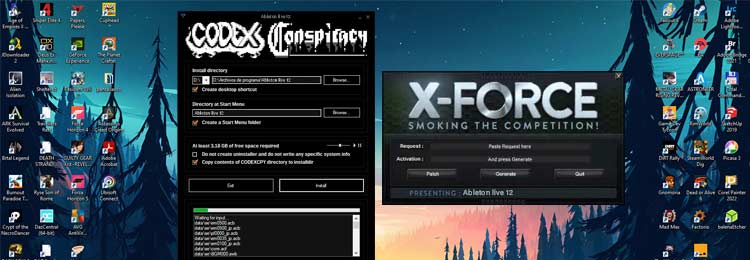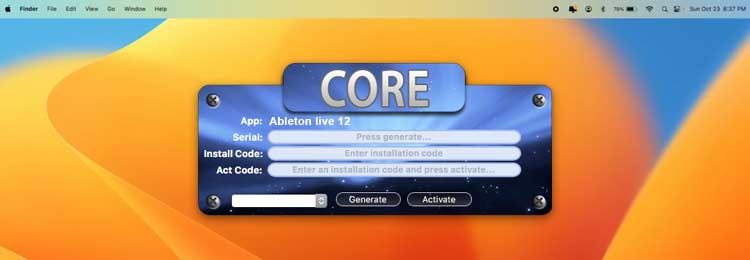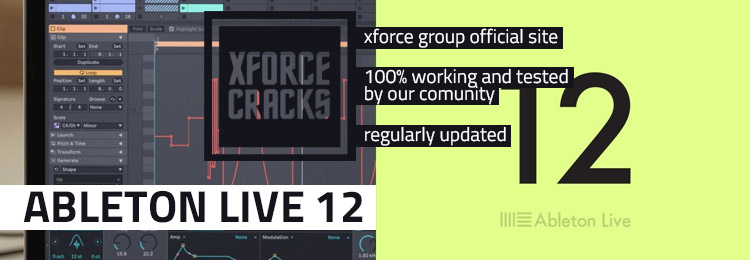Hello friends, great news! Here we bring you the latest version of the new Ableton live 12 crack patch created by the people at CODEXCPY, CORE and our friends of XFORCE.
This version is a simplified version of PainteR group’s “universal patcher” but much easier to install.
It is very simple to install: just follow the steps of the installer and finally mount the .iso image and run setup.exe as shown in the video tutorial. It only has an advertisement, if you want to avoid advertising you can register in the forum and download and install it from there. Any questions can be asked in the forum directly to its authors. Thank you for your continued support!
Download our Ableton live 12 crack-patch
Release Date: 7/27/2024 (Latest Windows version)
We kindly ask that you pass by a small ad to keep this website and forum up and running =)
Download CORE-KEYGEN Ableton live 12 for mac
Release Date: 7/27/2024 (Latest macOS version)
We kindly ask that you pass by a small ad to keep this website and forum up and running =)
Ableton live 12, Keygen & Crack
Keygen Version: v4.13.12
Release Date: 7/27/2024
Compatible with:
Microsoft® Windows® 11 or Windows 10 version 1809 or above
Apple® macOS® Monterey v12, Apple macOS Big Sur v11, Apple macOS Catalina v10.15
net framework 4.5 needed
Cracked by codexcpy.com & xforce-cacks.com


Ableton live 12
Among the notable new features in the browser is the Similarity Search. This tool, accessible from the library or within a drum rack, leverages neural networks to recommend sounds akin to a chosen sample. While it excels primarily with percussion sounds, it can be an inspiring way to diversify the sound palette of a project. Especially useful in a drum rack kit, it allows for swapping individual elements or experimenting with the entire kit. Unfortunately, this feature is not yet available within Live’s Simpler device, where it would be a perfect match.
Despite some features being better executed than others, Live 12 is a comprehensive update brimming with potential.
Advantages
- UI updates enhance Live’s workflow flexibility.
- Meld and Roar are both deep and powerful, yet fun and approachable.
- Generative MIDI tools provide ample opportunities for creative experimentation.
Drawbacks
- The revamped browser requires time and effort to master.
- Some MIDI tools have a somewhat disorganized implementation.
- Lack of MIDI generation or transformation capabilities from Push.
Consistent Performance
DAW updates often tout flashy new features, but the true measure of a DAW’s value lies in its consistency. Whether for professional or hobby use, these platforms are foundational for modern music creators. Transitioning from one version to another should be seamless. While new features might attract users to the latest updates, it’s the incremental enhancements to workflow that ensure long-term satisfaction.
Ableton has traditionally excelled in this regard. Despite numerous device additions over its 22-year history, Live’s overall design has remained consistent. Users can upgrade across several versions with minimal disruption, as most elements stay familiar: the browser on the left, devices at the bottom, and distinct UI views for the clip launcher and arrangement. Live 12 stands out as a significant update, as it challenges this longstanding familiarity.
Interface Enhancements
The UI layout sees the most significant changes in Live 12. Previous versions adhered to strict rules about workspace arrangement. While some resizing and element visibility options existed, constraints were firm: clip launcher and timeline in separate windows; Mixer only in Session view; clip and device parameters not shown side-by-side.
In Live 12, these conventions have been relaxed. For instance, the mixer view from the Live Session can now appear in the Arrangement, a logical change that seems overdue. Additionally, users can view a track’s device chain and selected clip simultaneously. Although these changes might reduce editing space on a laptop screen, they are clear usability improvements on larger screens.
Navigation within a Live Set is also improved. A new Navigate menu provides keyboard shortcuts for the main interface areas, and various Tab key combinations facilitate control navigation within each area. Although keyboard navigation can be efficient, the complexity of a Live project often necessitates switching between keyboard and mouse for optimal workflow.
Enhanced Flexibility in Version 12
Version 12 brings a significant shift in user interface flexibility, removing many of the previous constraints. Although the distinction between the Session view for clip-launching and the Arrangement timeline remains, you can now access the mixer, clip, and device panels from anywhere. This new setup allows the mixer to be used alongside the Arrangement view, and MIDI or audio clips to be displayed next to device interfaces, all within a single window.
While this can sometimes lead to a cluttered interface—especially on laptop screens—the added flexibility greatly enhances Live’s workflow. Users accustomed to quickly toggling between views and utilizing familiar keyboard shortcuts to manage elements might need some time to adapt to these new interactions. However, once accustomed to the changes, reverting to Live 11’s UI feels remarkably restrictive.
Revamped Library Browser
The redesigned Library browser in Live 12 modernizes how users locate devices, clips, samples, and other content. Moving away from the previous sub-folder system, it now uses dynamic tags and filters. This new system offers greater flexibility, particularly for saving custom search parameters, and reduces the divide between different content types. A search for ‘bass’ might yield device presets, clips, loops, and samples, all of which can be filtered by content type, source, or sound characteristics. Saved search parameters can be added to the library sidebar as shortcuts, updating as new content is imported or tagged.
However, this system introduces a divide between Ableton’s pre-tagged content and your own samples and third-party plugins, which by default are only minimally tagged (e.g., instrument, MIDI, sample, creator, file name). To fully benefit from the new system, it’s worthwhile to apply relevant tags to frequently used plugins and samples. Although straightforward, this tagging process can be time-consuming.
Browser Filters
Live’s browser has undergone a substantial overhaul. A major new feature is the ability to filter content by tags. These filters can apply to various objects within Live, from entire sets to individual clips. Available filters change based on the object type: for samples, tags include content type (sample or video), loop or one-shot, category, and sound character. For plugins, tags can indicate device or preset and properties like format (AU, VST2, VST3) and creator (vendor).
Filters are applied to the root selection in the browser’s left column, not the selected item on the right. Tags are highlighted based on available matches, guiding users to more precise searches. Tags can be edited, allowing custom tags to be added. For instance, I added my name to some Max For Live devices I created, and the tags persisted even when moving devices between folders. Tagging relies on names, so changing a name removes the associated tags.
Although I might not spend an afternoon tagging all my projects, I found it immediately helpful to filter plugins by format, ensuring consistent use of VST3 over VST2 or AU. Tagging entire set files could benefit certain workflows.
Generative MIDI Tools
Aside from UI changes, Live 12 introduces an impressive suite of generative MIDI tools. These features, available within MIDI clips, are divided into two categories: Generators and Transformations. Generators populate empty clips with MIDI data, while Transformations modify existing MIDI patterns. Each category includes tools for specific use-cases: Generators can create percussive patterns (Rhythm), melodies (Seed), chords (Stacks), or arpeggiated riffs (Shape). Suite owners can also use Max MIDI generators within clips.
Advanced MIDI Manipulation
Transformations in Live 12 can perform various tasks such as arpeggiating chords, modifying note quantisation or humanisation, shifting MIDI event positions and timings, and enhancing patterns with flams and ghost notes. These MIDI tools are a remarkable and inspiring addition to the DAW, inviting users to delve into endless creative explorations. However, some areas lack polish. For example, using the Stacks chord generator to create progressions requires manual adjustments of each chord’s shape and root note. An auto-generate function for common progressions would be beneficial. Additionally, clearer chord labels would serve as a valuable learning tool. The current setup can also lead to accidentally overwriting or transforming unintended notes, making the workflow feel somewhat cumbersome, though this can be easily undone.
Project-Wide Scale Settings
Live 12 introduces a master scale setting, allowing users to set a scale for the entire project, which is automatically applied to new clips. This feature is convenient, but individual MIDI or audio clips can still have their own scale settings, enabling key/scale changes mid-project or track—a useful feature for live performances. The DAW now includes a ‘scale awareness’ mode for several stock devices, locking pitch-based parameters like MIDI effects, synth oscillator tuning, and pitch-shift effects to the current scale. This helps avoid unwanted harmonic clashes (though it can be disabled if necessary), ensuring that switching between clips with different keys/scales prompts all relevant devices to adjust accordingly.
Micro-Tuning and Non-Western Scales
Live 12 also supports micro-tunings and non-Western scales through a tuning pool, similar to the Groove Pool. Engaging a tuning from this pool deactivates the global scale setting, applying the selected tuning across all project clips. Users can edit and import custom tunings via this pool, enhancing the DAW’s versatility for diverse musical styles.
Additional Content in Live 12 Suite
Live 12 Suite offers additional downloadable content in the form of Packs from Ableton’s site. Two new Packs are available for download. The first, Lost and Found, is a sample pack focused on percussive sounds derived from household objects and material textures, curated into fun drum kits and unique instruments. The second, more intriguing, is the Max-powered Performance Pack. This bundle includes four customizable devices aimed at addressing advanced and niche performance needs within Live’s workflow. For controller users, particularly those using Push, Performer provides a tool to configure banks of top-level macro controls and set up complex, multi-destination modulation, surpassing the capabilities of Live’s basic modulators. Additional tools facilitate live looping in the arrangement view, creating spontaneous arrangements and variations.
We believe that cracking and sharing softwares is something great and needed, but please never forget to support his creators. If you can afford the product PLEASE buy it =)
*—————–* !!!!! Accept no imitation / X-FORCE * * We are the world #1 !!!!! *——————*
**********************************************************************************************************


crack is too hard to be done
thanks
Does this work for 1.9.4 version? Thank you
If someone can\’t path, run patch with admin and try again.
Hi NuclearStorm, Could you upload some instructions? Thanks
where is the reg file?
Thank you very much.
Thanks
TNX MAN!!!
Where is the keygen?!!
thk you sir..
Hey, I have some enquiries. I have been using xforce keygen for a long time. Recently, I got to crack my autocad 2017. But when I run as admin. I click patch. It keep stating debug priviledge. I tried troubleshooting compatibilty and all. But it is still not working
…thanks !
I understand perfectly your instructions because I\’ve been online forever but what about newbies? Don\’t they deserve consideration and better instructions, so that they can teach others in the future? I think you\’re arrogant.
The crack keeps telling me that the paste version is corrupt
works OK as a standalone but plugins says \’could not be loaded as not properly signed\’.
how to download :S ??
How to download…i only got 7zip packHow about WordPerfect 2020 Keygen? Would be nice.
link is not working
CHEERS TY
The .msi file downloaded through your link open a window DorstenialNativeInstall that says: there in no internet connection but there is so what can I do
please upload fastest video downloader
THANKSSSSS ALOOOOTTTTTT
Hello, I would like to know if you can give me a link to download X-Force 2021 Keygen for AUTOCAD 2021
Cant patch
works great
Works great! Thanks!
great
=D thanks
Just a newbie, a keygen will always set it off.
Thanks for sharing
We need a Mac OS Catalin version too
Hi, I’d appreciate adding mirror sites for the downloads. Thanks..
Remember the first version of this on DOS days on a 286… Wow.
what is the password for zip ??!!!
where is the Key pls rply
Super. Thank you…!
please upload fastest video downloader
thank you